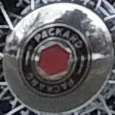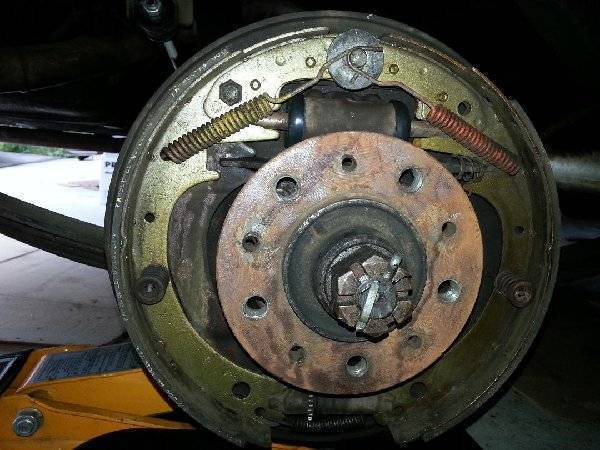Topic: 1804-5-7-8 Rear Brake Drums
|
Re: 1804-5-7-8 Rear Brake Drums
|
||||
|---|---|---|---|---|
|
Home away from home

|
Tom Lester had a similar problem on a car with irreplaceable drums. He had new ones turned out of blocks of steel and they worked great. Thus, the problem is not insurmountable given cash and a good machinist.
Posted on: 2020/2/23 8:37
|
|||
|
||||
|
Re: 1804-5-7-8 Rear Brake Drums
|
||||
|---|---|---|---|---|
|
Home away from home
|
Quote:
Don, thanks for the reply and the photo. Concentric alignment of the drums on the hubs would be a must for proper functioning brakes. Maybe some sleeves in the drum holes would fix the problem. Interesting to see that I am not the only one thinking about this. Now, back to our regular program.
Posted on: 2020/2/23 13:43
|
|||
|
We move toward
And make happen What occupies our mind... (W. Scherer) |
||||
|
||||
|
Re: 1804-5-7-8 Rear Brake Drums
|
||||
|---|---|---|---|---|
|
Forum Ambassador

|
Quality brake drums of the era and later were made by the "CentriFuse" (registered trademark) process which effectively applied via some centrifugal casting process a layer of cast iron-like alloy to the inner drum surface. This is because it has far superior frictional properties for braking than simple steel which for a while was (rather unsatisfactorily) used on early Model A Fords, and other cheap cars.
If you regularly follow along on the AACA forums you'll find a large number of threads about processes like spray welding and plasma metalization to restore a proper metal brake surface to old drums. I'm not sure how far these attempts have progressed but its important work as the supply of serviceable drums slowly diminishes. DON'T cut drums unnecessarily, and most importantly, don't discard old drums!! stemco.com/product/genuine-centrifuse/
Posted on: 2020/2/23 14:39
|
|||
|
||||
|
Re: 1804-5-7-8 Rear Brake Drums
|
||||
|---|---|---|---|---|
|
Home away from home

|
When I say "turned out of blocks of steel" I don't mean he (Tom Lester) went down the local junk yard and picked up some old manhole covers. Obviously he spoke to metallurgists at the suppliers and bought the best materials.
I have to hand it to the guy. He had this car that was totally unsafe and made it work without buying crap out of the Summit Racing catalogue. Of course it does help if you own a big manufacturing operation. So if you need brake drums for your Duesenberg it can be done as demonstrated by old man Lester.
Posted on: 2020/2/24 17:52
|
|||
|
||||
|
Re: 1804-5-7-8 Rear Brake Drums
|
||||
|---|---|---|---|---|
|
Just popping in
|
I am trying to remove the driver side rear brake drum. First, is the axel nut reverse threaded? Once the nut is off how is the drum best removed? 1952-3 four door sedan ultramatic. Dennis
Posted on: 2022/5/24 23:59
|
|||
|
||||
|
Re: 1804-5-7-8 Rear Brake Drums
|
||||
|---|---|---|---|---|
|
Home away from home
|
The nut is tight but not reverse-theaded but may have a cotter key too so look for that. Once the cotter key has been removed, it will take a socket and long breaker bar to get it loose. You can't do it with a regular ratchet.
You'll need a brake drum puller to remove the drum itself.
Posted on: 2022/5/25 0:03
|
|||
|
All generalities are false.
Once I thought I was wrong but I was mistaken. Don Pierson Packard / IMPERIAL page CA DMV Licensed Vehicle VIN Verification 1951 Henney-Packard 3-Door Long Wheelbase Air Force Ambulance The 1951 Henney-Packard is For Sale! 1954 Packard Patrician 1954 Packard Patrician Parts Car 1956 Clipper Custom Sedan |
||||
|
||||
|
Re: 1804-5-7-8 Rear Brake Drums
|
||||
|---|---|---|---|---|
|
Forum Ambassador
|
If the nut is to spec, it should be torqued in the range of 200-270 ft/lbs so as Don said, will need a socket and long breaker bar to get it started unscrewing. Even when the nut is loose, if the drum has not been removed in many years it may also prove to be very difficult to break free of the axle taper.
Use of a large and proper style puller is imperative. You can probably find something to rent but it needs to be the size and type used on larger pickups and small trucks. Those used for the typical cars we are now used to will not be large enough. Even with the proper puller you may need to get it tight and let it sit pulling on the drum for a period. Come back from time to time and give the screw another hit with the hammer. Sometimes this can take hours. Above all, while the puller is attached and pulling have the nut loosened a few turns but leave it and the washer still threaded on the axle shaft so once the drum breaks free it can not pop off the axle. All that force suddenly released can send the drum flying and do real damage if unrestrained. Here is a thread showing an older version of the proper type puller in use and if you do a search of the forum on brake drum removal there are other more modern versions of similar type pullers shown.packardinfo.com/xoops/html/modules/newbb ... d=5026&post_id=53964#forumpost53964
Posted on: 2022/5/25 8:44
|
|||
|
Howard
|
||||
|
||||
|
Re: 1804-5-7-8 Rear Brake Drums
|
||||
|---|---|---|---|---|
|
Not too shy to talk
|
Quote:
Old thread I know but I am doing the rear brakes on my 49 and had to buy the special whacka mole puller to get the hub off. I was thinking the same thing, just drill out the rivets and boom, you can remove the drum without the hub but then I read your comment on having issues on keeping the holes aligned. I think I will do this to mine but I will grind the heads flat on the face of the drum then separate the two pieces. If Im right that will leave the rivets in the hub and I can tack weld them in place and after a little clearancing with the disk sander I bet they would still work as pegs to align the drums. The idea of having to use a puller just to get to the brake shoes, thats not the best design.
Posted on: 2024/10/17 9:17
|
|||
|
||||
|
Re: 1804-5-7-8 Rear Brake Drums
|
||||
|---|---|---|---|---|
|
Webmaster
|
Tapered axle rear drums were common on pretty much all cars until the mid-50s.
I would not drill out the rivets. It is cheaper to buy the correct tool, then to cludge and reengineer something, and then have poor or unsafe results. Most folks only need to change the rear shoes once during their entire ownership.
Posted on: 2024/10/17 9:53
|
|||
|
-BigKev
1954 Packard Clipper Deluxe Touring Sedan -> Registry | Project Blog 1937 Packard 115-C Convertible Coupe -> Registry | Project Blog |
||||
|
||||


 (129.67 KB)
(129.67 KB)







